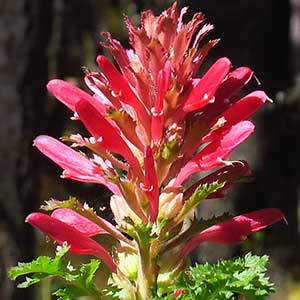Pedicularis densiflora
Pedicularis attollens
Indian warrior, warrior's plume
attol lousewort, attoll lousewort, elephant snouts, little elephant head, little elephant's head, woolly Mammoth
basal 1–10, blade lanceolate, 30–200 x 20–70 mm, 2(or 3)-pinnatifid, margins of adjacent lobes nonoverlapping or extensively overlapping distally, 1-serrate, surfaces glabrous, hispid, or downy;
cauline 4–20, blade lanceolate, 15–250 x 5–100 mm, 2-pinnatifid, margins of adjacent lobes nonoverlapping or extensively overlapping distally, serrate, surfaces glabrous, hispid, or downy.
basal 5–25, blade elliptic, 60–150(or 200–250) x 3–23 mm, 1- or 2-pinnatifid, margins of adjacent lobes nonoverlapping, serrate, surfaces glabrous or scattered glands;
cauline 2–20, blade elliptic, 5–50(–100) x 1–5 mm, undivided or 1(or 2)-pinnatifid, margins of adjacent lobes nonoverlapping, serrate, surfaces glabrous.
simple, 1–5, exceeding basal leaves, each 10–50-flowered;
bracts lanceolate to trullate, 10–35 x 3–5 mm, undivided or 1-pinnatifid, proximal margins entire, distal 1- or 2-serrate, surfaces glabrous.
simple, 1–3, exceeding basal leaves, each 10–50-flowered;
bracts lanceolate to triangular, 5–10 x 3–10 mm, pinnatifid, margins entire, surfaces glabrous or tomentose.
2–4 mm.
1.2–1.6 mm.
calyx 9–18 mm, downy to tomentose, lobes 5, triangular, 3–4 mm, apex entire, ciliate;
corolla 23–43 mm, tube dark red, purple, or orange-yellow, rarely white, 8–18 mm;
galea dark red, purple, or orange-yellow, rarely white, 15–25 mm, beakless, margins entire medially and distally, apex straight;
abaxial lip dark red, purple, or orange-yellow, rarely white, 8–15 mm.
calyx 4–5 mm, glabrous or tomentose, lobes 5, triangular, 2–2.5 mm, apex entire, glabrous;
corolla 6–8 mm, tube pink, rarely white, 3–6 mm;
galea white or pink with 2 purple spots or stripes, 1–2 mm, beaked, beak coiled, 3–6 mm, base curving, margins entire medially and distally, apex not surrounded by abaxial lip, axis of coil nearly vertical;
abaxial lip pendulous, white or pink with purple stripe, 4–5.5 mm.
= 16.
= 16.
Pedicularis densiflora
Pedicularis attollens
Scarlet corollas with an undomed, toothless galea and two- or three-pinnatifid leaves are diagnostic of Pedicularis densiflora. This species occurs in forested subalpine regions of southern Oregon, western slopes of the Sierra Nevada, and the Coast Ranges of California south to Baja California. Herbarium records indicate northern populations of P. densiflora occur at higher elevations than do more southern populations.
(Discussion copyrighted by Flora of North America; reprinted with permission.)
Subspecies 2 (2 in the flora).
The flowers of Pedicularis attollens, like those of P. groenlandica, resemble an elephant’s head, and A. Heller placed them both in Elephantella. The short, upturned beak, in contrast to the long, more horizontal downturned beak of P. groenlandica, is a distinguishing feature of P. attollens. Whereas P. groenlandica occurs across much of western and arctic North America, P. attollens is found primarily in the Cascade Range of central and southern Oregon and the Sierra Nevada of California and Nevada. It is also reported from the Klamath Range to the west and the White and Sweetwater mountains and the Warner Range to the east of the Sierra Nevada.
(Discussion copyrighted by Flora of North America; reprinted with permission.)
1. Basal leaves 1-pinnatifid. | subsp. attollens |
1. Basal leaves 2-pinnatifid. | subsp. protogyna |


